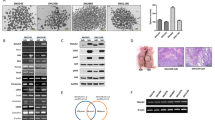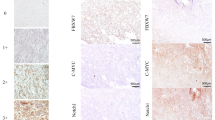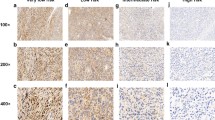Abstract
Background
Gastrointestinal (GI) cancer, including gastric cancer (GC), colorectal cancer (CRC), and esophageal squamous cell carcinoma (ESCC), is the most common malignancy worldwide. To identify genes that encode transmembrane proteins present in GI cancer, Escherichia coli ampicillin secretion trap libraries were generated from MKN-74 GC cells, and BST2 was identified as overexpressed in GC. This study analyzed the expression and function of the BST2 gene in human GI cancers and examined the relationship between bone marrow stromal antigen-2 (BST-2) expression and GI patient clinicopathologic characteristics.
Methods
Expression and distribution of BST-2 protein was analyzed by immunohistochemistry in 180 GC cases, 140 CRC cases, and 132 ESCC cases. Cell growth was analyzed by 3-(4,5-dimethylthiazol-2-yl)-2,5-diphenyltetrazolium bromide (MTT) assay.
Results
Immunohistochemical analysis of BST-2 in GC tissues showed that 65 (36 %) of 180 GC cases were positive for BST-2. Uni- and multivariate analyses demonstrated that BST-2 expression is an independent prognostic classifier of GC patients. Immunohistochemical analysis showed that 46 % of 140 CRC cases and 27 % of 132 ESCC cases were positive for BST-2. In ESCC, BST-2 expression was an independent prognostic predictor for survival. The growth of BST2 small interfering RNA (siRNA)-transfected GC cells was significantly slower than the growth of negative control siRNA-transfected GC cells. The levels of phosphorylated epidermal growth factor receptor, extracellular signal-regulated kinase, and Akt were lower in BST2 siRNA-transfected GC cells than in control cells.
Conclusions
The results suggest that BST-2 is involved in tumor progression and serves as an independent prognostic classifier for patients with GC. Because BST-2 is expressed on the cell membrane, BST-2 could be a therapeutic target for GC, CRC, and ESCC.


Similar content being viewed by others
References
Yasui W, Oue N, Ito R, Kuraoka K, Nakayama H. Search for new biomarkers of gastric cancer through serial analysis of gene expression and its clinical implications. Cancer Sci. 2004;95:385–92.
Oue N, Sentani K, Sakamoto N, Yasui W. Clinicopathologic and molecular characteristics of gastric cancer showing gastric and intestinal mucin phenotype. Cancer Sci. 2015;106:951–8.
Aizawa M, Nagatsuma AK, Kitada K, et al. Evaluation of HER2-based biology in 1006 cases of gastric cancer in a Japanese population. Gastric Cancer. 2014;17:34–42.
Van Loon K, Venook AP. Adjuvant treatment of colon cancer: what is next? Curr Opin Oncol. 2011;23:403–9.
Ferguson DA, Muenster MR, Zang Q, et al. Selective identification of secreted and transmembrane breast cancer markers using Escherichia coli ampicillin secretion trap. Cancer Res. 2005;65:8209–17.
Anami K, Oue N, Noguchi T, et al. Search for transmembrane protein in gastric cancer by the Escherichia coli ampicillin secretion trap: expression of DSC2 in gastric cancer with intestinal phenotype. J Pathol. 2010;221:275–84.
Anami K, Oue N, Noguchi T, et al. TSPAN8, identified by Escherichia coli ampicillin secretion trap, is associated with cell growth and invasion in gastric cancer. Gastric Cancer (in press).
Oo HZ, Sentani K, Sakamoto N, et al. Identification of novel transmembrane proteins in scirrhous-type gastric cancer by the Escherichia coli ampicillin secretion trap (CAST) method: TM9SF3 participates in tumor invasion and serves as a prognostic factor. Pathobiology. 2014;81:138–48.
Oo HZ, Sentani K, Sakamoto N, et al. Overexpression of ZDHHC14 promotes migration and invasion of scirrhous type gastric cancer. Oncol Rep. 2014;32:403–10.
Kupzig S, Korolchuk V, Rollason R, Sugden A, Wilde A, Banting G. Bst-2/HM1.24 is a raft-associated apical membrane protein with an unusual topology. Traffic. 2003;4:694–709.
Goto T, Kennel SJ, Abe M, et al. A novel membrane antigen selectively expressed on terminally differentiated human B cells. Blood. 1994;84:1922–30.
Ozaki S, Kosaka M, Wakatsuki S, Abe M, Koishihara Y, Matsumoto T. Immunotherapy of multiple myeloma with a monoclonal antibody directed against a plasma cell-specific antigen, HM1.24. Blood. 1997;90:3179–86.
Walter-Yohrling J, Cao X, Callahan M, et al. Identification of genes expressed in malignant cells that promote invasion. Cancer Res. 2003;63:8939–47.
Cai D, Cao J, Li Z, et al. Up-regulation of bone marrow stromal protein 2 (BST2) in breast cancer with bone metastasis. BMC Cancer. 2009;9:102.
Yokoyama T, Enomoto T, Serada S, et al. Plasma membrane proteomics identifies bone marrow stromal antigen 2 as a potential therapeutic target in endometrial cancer. Int J Cancer. 2013;132:472–84.
Wang W, Nishioka Y, Ozaki S, et al. HM1.24 (CD317) is a novel target against lung cancer for immunotherapy using anti-HM1.24 antibody. Cancer Immunol Immunother. 2009;58:967–76.
Sobin LH, Wittekind CH, eds. TNM classification of malignant tumors. 6th ed. New York: Wiley; 2002, pp 65–8.
Lauren P. The two histological main types of gastric carcinoma: diffuse and so-called intestinal-type carcinoma: an attempt at a histo-clinical classification. Acta Pathol Microbiol Scand. 1965;64:31–49.
Oue N, Noguchi T, Anami K, et al. Cytokeratin 7 is a predictive marker for survival in patients with esophageal squamous cell carcinoma. Ann Surg Oncol. 2012;19:1902–10.
Johnson AH, Frierson HF, Zaika A, et al. Expression of tight-junction protein claudin-7 is an early event in gastric tumorigenesis. Am J Pathol. 2005;167:577–84.
Li S, Schmitz KR, Jeffrey PD, Wiltzius JJ, Kussie P, Ferguson KM. Structural basis for inhibition of the epidermal growth factor receptor by cetuximab. Cancer Cell. 2005;7:301–11.
Sayeed A, Luciani-Torres G, Meng Z, Bennington JL, Moore DH, Dairkee SH. Aberrant regulation of the BST2 (Tetherin) promoter enhances cell proliferation and apoptosis evasion in high grade breast cancer cells. PLoS One. 2013;8:e67191.
Becker M, Sommer A, Kratzschmar JR, Seidel H, Pohlenz HD, Fichtner I. Distinct gene expression patterns in a tamoxifen-sensitive human mammary carcinoma xenograft and its tamoxifen-resistant subline MaCa 3366/TAM. Mol Cancer Ther. 2005;4:151–68.
Staudinger M, Glorius P, Burger R, et al. The novel immunotoxin HM1.24-ETA’ induces apoptosis in multiple myeloma cells. Blood Cancer J. 2014;4:e219.
Takeuchi K, Ito F. EGF receptor in relation to tumor development: molecular basis of responsiveness of cancer cells to EGFR-targeting tyrosine kinase inhibitors. FEBS J. 2010;277:316–26.
Harada T, Ozaki S. Targeted therapy for HM1.24 (CD317) on multiple myeloma cells. Biomed Res Int. 2014;2014:965384.
Acknowledgment
This work was supported in part by Grants-in-Aid for Cancer Research from the Ministry of Education, Culture, Sports, Science, and Technology of Japan and from the Ministry of Health, Labour, and Welfare of Japan.
Conflict of interest
There are no conflicts of interest.
Author information
Authors and Affiliations
Corresponding author
Electronic supplementary material
Below is the link to the electronic supplementary material.
Rights and permissions
About this article
Cite this article
Mukai, S., Oue, N., Oshima, T. et al. Overexpression of Transmembrane Protein BST2 is Associated with Poor Survival of Patients with Esophageal, Gastric, or Colorectal Cancer. Ann Surg Oncol 24, 594–602 (2017). https://doi.org/10.1245/s10434-016-5100-z
Received:
Published:
Issue Date:
DOI: https://doi.org/10.1245/s10434-016-5100-z




